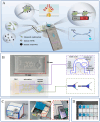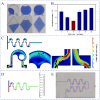A Microfluidic Biosensor for Quantitative Detection of Salmonella in Traditional Chinese Medicine
- PMID: 39852061
- PMCID: PMC11763935
- DOI: 10.3390/bios15010010
A Microfluidic Biosensor for Quantitative Detection of Salmonella in Traditional Chinese Medicine
Abstract
Microbial contamination is an important factor threatening the safety of Chinese medicine preparations, and microfluidic detection methods have demonstrated excellent advantages in the application of rapid bacterial detection. In our study, a novel optical biosensor was developed for the rapid and sensitive detection of Salmonella in traditional Chinese medicine on a microfluidic chip. Immune gold@platinum nanocatalysts (Au@PtNCs) were utilized for specific bacterial labeling, while magnetic nano-beads (MNBs) with a novel high-gradient magnetic field were employed for the specific capture of bacteria. The immune MNBs, immune Au@PtNCs, and bacterial samples were introduced into a novel passive microfluidic micromixer for full mixing, resulting in the formation of a double-antibody sandwich structure due to antigen-antibody immune reactions. Subsequently, the mixture flowed into the reaction cell, where the MNBs-Salmonella-Au@PtNCs complex was captured by the magnetic field. After washing, hydrogen peroxide-tetramethylbenzidine substrate (H2O2-TMB) was added, reacting with the Au@PtNCs peroxidase to produce a blue reaction product. This entire process was automated using a portable device, and Salmonella concentration was analyzed via a phone application. This simple biosensor has good specificity with a detection range of 9 × 101-9 × 105 CFU/mL and can detect Salmonella concentrations as low as 90 CFU/mL within 74 min. The average recoveries of the spiked samples ranged from 76.8% to 109.5.
Keywords: biosensor; microbial contamination; microfluidics; nanocatalysts; traditional Chinese medicine.
Conflict of interest statement
The authors declare no conflicts of interest.
Figures







Similar articles
-
A finger-actuated microfluidic biosensor for colorimetric detection of foodborne pathogens.Food Chem. 2022 Jul 1;381:131801. doi: 10.1016/j.foodchem.2021.131801. Epub 2021 Dec 8. Food Chem. 2022. PMID: 35124486
-
Optical Biosensor for Rapid Detection of Salmonella typhimurium Based on Porous Gold@Platinum Nanocatalysts and a 3D Fluidic Chip.ACS Sens. 2020 Jan 24;5(1):65-72. doi: 10.1021/acssensors.9b01472. Epub 2020 Jan 7. ACS Sens. 2020. PMID: 31875386
-
A multimetallic nanozyme enhanced colorimetric biosensor for Salmonella detection on finger-actuated microfluidic chip.Food Chem. 2024 Dec 1;460(Pt 1):140488. doi: 10.1016/j.foodchem.2024.140488. Epub 2024 Jul 22. Food Chem. 2024. PMID: 39043075
-
Microfluidic Sampling and Biosensing Systems for Foodborne Escherichia coli and Salmonella.Foodborne Pathog Dis. 2022 Jun;19(6):359-375. doi: 10.1089/fpd.2021.0087. Foodborne Pathog Dis. 2022. PMID: 35713922 Review.
-
Recent advancements in microfluidic chip biosensor detection of foodborne pathogenic bacteria: a review.Anal Bioanal Chem. 2022 Apr;414(9):2883-2902. doi: 10.1007/s00216-021-03872-w. Epub 2022 Jan 21. Anal Bioanal Chem. 2022. PMID: 35064302 Free PMC article. Review.
References
-
- CDC Salmonella. [(accessed on 3 October 2024)]; Available online: https://www.cdc.gov/salmonella/index.html.
-
- Commission N.P. Pharmacopoeia of the People’s Republic of China (Part 4), 2020 Ed. China Pharmaceutical Science and Technology Press; Beijing, China: 2020. p. 857.
-
- Chen S., Sun Y., Fan F., Chen S., Zhang Y., Zhang Y., Meng X., Lin J.-M. Present status of microfluidic PCR chip in nucleic acid detection and future perspective. TrAC Trends Anal. Chem. 2022;157:116737. doi: 10.1016/j.trac.2022.116737. - DOI
MeSH terms
Substances
Grants and funding
LinkOut - more resources
Full Text Sources
Molecular Biology Databases

